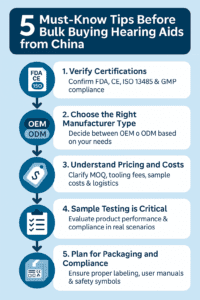With the rise of global medical device sourcing, China has become a leading supplier of affordable and high-quality hearing aids. However, bulk procurement—especially of medical electronics—requires careful planning, verification, and vendor assessment.
Why Source Hearing Aids from China?
- Cost-effective production due to scale and mature supply chains
- OEM/ODM customization for private labels or local market adaptation
- Wide range of models (CIC, BTE, RIC, Bluetooth, rechargeable)
- Export-ready factories certified with FDA, CE, ISO, and GMP
- Growing innovation in noise reduction, DSP chips, and wireless tech
1. Verify Certifications (FDA, CE, ISO)
When dealing with medical-grade products like hearing aids, certifications are not optional—they’re a legal and quality requirement.
What to Ask For:
- FDA Establishment Registration
- CE Marking (MDR compliant)
- ISO 13485:2016 Certification
- GMP Compliance
How to Verify:
- FDA Registration Lookup
- NANDO database for CE
- IAF CertSearch for ISO
2. Choose the Right Manufacturer Type (OEM vs ODM)
| Type | OEM | ODM |
|---|---|---|
| Design Control | Limited (your brand on existing product) | Full (new product development) |
| Lead Time | Shorter | Longer (prototyping required) |
| Cost | Lower | Higher |
| MOQ | Lower | Higher |
3. Understand Pricing, MOQ, and Hidden Costs
- What is the minimum order quantity?
- Are there tooling fees for molds or new casing designs?
- Is the sample cost refundable?
- Who pays for certification support?
- Are shipping, tax, and customs included?
4. Sample Testing is Critical
Never place a bulk order without verifying device performance:
- Sound clarity and gain
- Feedback control and noise filtering
- Battery duration
- Bluetooth function (if available)
- Fit and comfort for users
Consider third-party testing or in-person audit when possible.
5. Packaging, Labeling, and Documentation
- Branded boxes, manuals, and warranty cards
- Proper labeling for FDA/CE compliance
- Instructions in destination market language
- FNSKU, QR codes, barcodes for e-commerce

Conclusion: Partner Carefully, Scale Confidently
Bulk buying hearing aids from China can deliver great value—if you work with certified, responsive suppliers. Following these tips can help you mitigate risk, control costs, and ensure quality delivery for your brand.
📩 Need Help Getting Started?
Contact us today streamline your sourcing.




